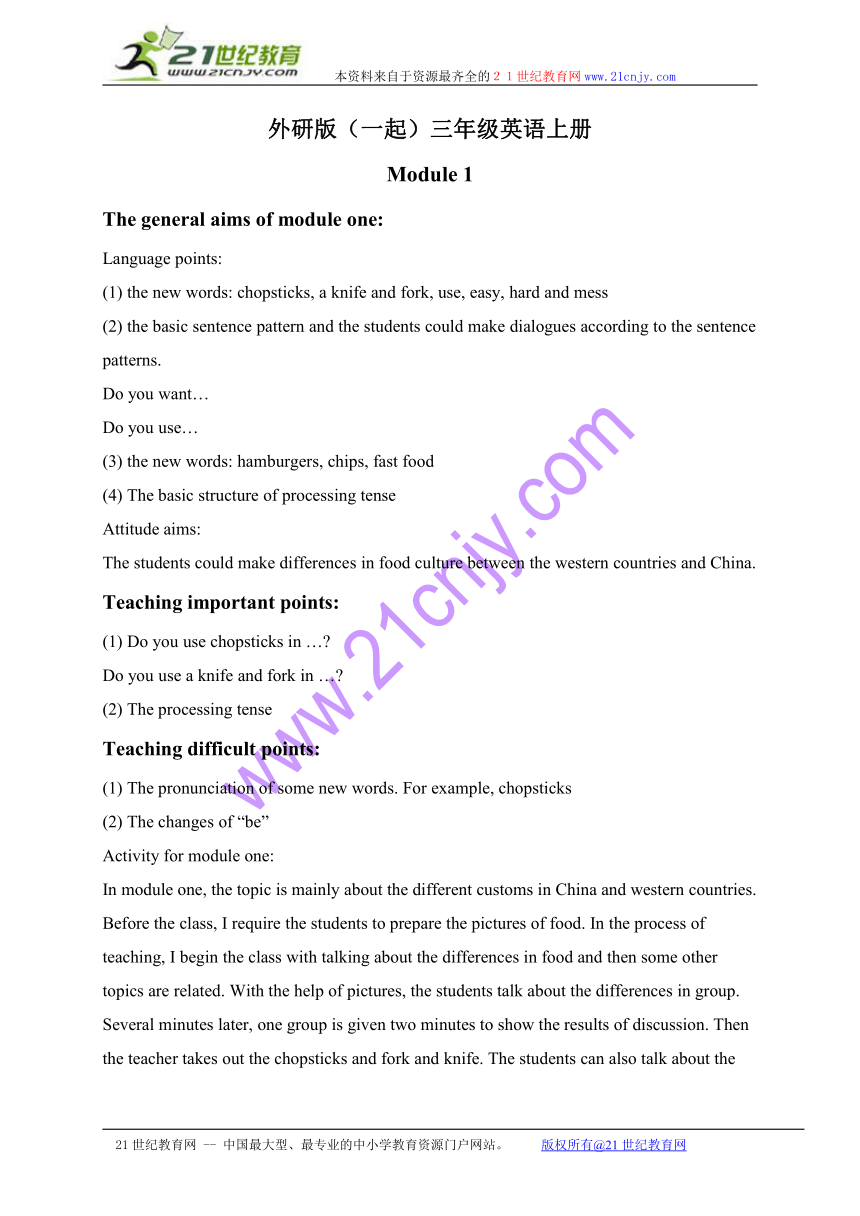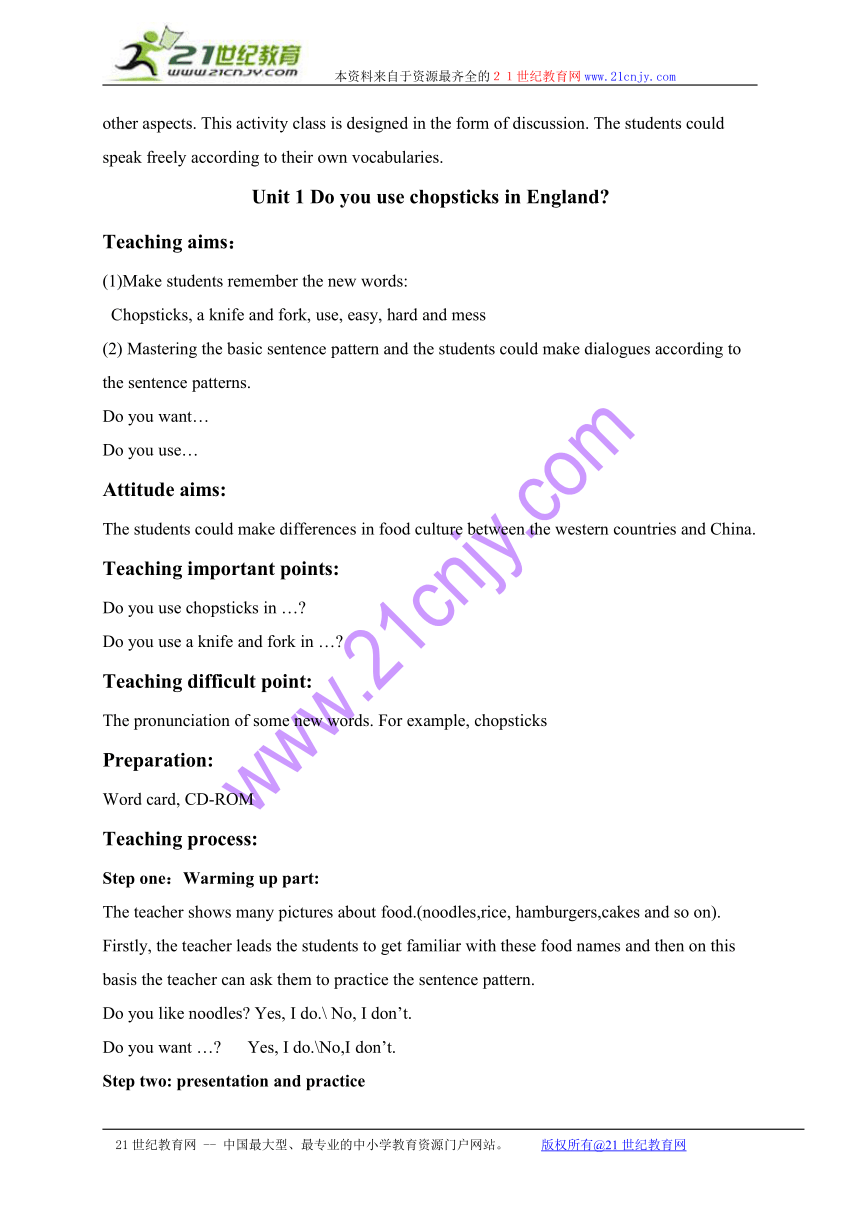外研版(一起)三年级英语上册教案 module 1 unit 1(2)
文档属性
| 名称 | 外研版(一起)三年级英语上册教案 module 1 unit 1(2) |  | |
| 格式 | rar | ||
| 文件大小 | 12.9KB | ||
| 资源类型 | 教案 | ||
| 版本资源 | 外研版(一年级起点) | ||
| 科目 | 英语 | ||
| 更新时间 | 2009-12-02 18:11:00 | ||
图片预览


文档简介
本资料来自于资源最齐全的21世纪教育网www.21cnjy.com
外研版(一起)三年级英语上册
Module 1
The general aims of module one:
Language points:
(1) the new words: chopsticks, a knife and fork, use, easy, hard and mess
(2) the basic sentence pattern and the students could make dialogues according to the sentence patterns.
Do you want…
Do you use…
(3) the new words: hamburgers, chips, fast food
(4) The basic structure of processing tense
Attitude aims:
The students could make differences in food culture between the western countries and China.
Teaching important points:
(1) Do you use chopsticks in …
Do you use a knife and fork in …
(2) The processing tense
Teaching difficult points:
(1) The pronunciation of some new words. For example, chopsticks
(2) The changes of “be”
Activity for module one:
In module one, the topic is mainly about the different customs in China and western countries. Before the class, I require the students to prepare the pictures of food. In the process of teaching, I begin the class with talking about the differences in food and then some other topics are related. With the help of pictures, the students talk about the differences in group. Several minutes later, one group is given two minutes to show the results of discussion. Then the teacher takes out the chopsticks and fork and knife. The students can also talk about the other aspects. This activity class is designed in the form of discussion. The students could speak freely according to their own vocabularies.
Unit 1 Do you use chopsticks in England
Teaching aims:
(1)Make students remember the new words:
Chopsticks, a knife and fork, use, easy, hard and mess
(2) Mastering the basic sentence pattern and the students could make dialogues according to the sentence patterns.
Do you want…
Do you use…
Attitude aims:
The students could make differences in food culture between the western countries and China.
Teaching important points:
Do you use chopsticks in …
Do you use a knife and fork in …
Teaching difficult point:
The pronunciation of some new words. For example, chopsticks
Preparation:
Word card, CD-ROM
Teaching process:
Step one:Warming up part:
The teacher shows many pictures about food.(noodles,rice, hamburgers,cakes and so on). Firstly, the teacher leads the students to get familiar with these food names and then on this basis the teacher can ask them to practice the sentence pattern.
Do you like noodles Yes, I do.\ No, I don’t.
Do you want … Yes, I do.\No,I don’t.
Step two: presentation and practice
The teacher makes use of the picture “noodles” and a new word “chopsticks” can be leaded out.
T: I like noodles. I eat noodles with chopsticks.
The teacher takes out the real chopsticks and then says the new word. At the same
time, the teacher shows the picture of chopsticks.
An activity can be made here. The title of the activity is saying words as quickly. The pronunciation of new word is a difficult point. So the teacher should ask students to practice more.
Step three:
The new word “use” can be leaded out in the process of communication.
T: Can you use chopsticks
The word card of use should be shown.
We use chopsticks in China. And the teacher writes the sentence on the blackboard.
We use chopsticks.
Do you use chopsticks Yes, we do. No, we don’t.
Ask and answer in pairs.
The teacher inquires the students if the English people use
Chopsticks and a knife and fork will be leaded out.
T: We use chopsticks in China. Do the English people use chopsticks
S: No, they don’t.
English people use a knife and fork.
Do you use chopsticks / a knife and fork Yes, I do. No, I don’t.
Step four:
(1)Presentation of the text.
Amy and Daming are in the park. They want to eat noodles. Watch the CD-ROM,
then answer the questions: “Does Amy use chopsticks in England ”
The students look at the CO-ROM and then answer questions.
Now Amy is using chopsticks. Watch again, then answer the next question:Are the
chopsticks “easy” or “hard” for her
easy – hard
Chopsticks are hard for Amy.
A knife and fork are easy for her.Some other opposite words are shown here.
big-small
long-short
fat-thin
hot-cold
white-black
easy-hard
Listen again, then answer:
Are the chopsticks “easy” or “hard” for English people
T: If I say “big”. You should say “small”. Please say the words as quickly as you can.
Chopsticks are hard for English people. So Amy make the mess.
mess /e/
Then the students read the passage again.
Find the sentences, “ Do you … ”. Then circle them.
Practice:
(1)In China, we use __________. In England, people use ________.
Chopsticks are ________ for Chinese people. They are _______ for English people.
Chant:
Do you use chopsticks Yes I do. Yes, I do.
We use chopsticks in China.
They’re easy for us.
Do you use ___________ Yes I do. Yes, I do.
We use ________ in England.
They’re easy for us.
Homework:
Ask students to practice the sentence patterns that they have learned in this lesson.
21世纪教育网 -- 中国最大型、最专业的中小学教育资源门户网站。 版权所有@21世纪教育网
外研版(一起)三年级英语上册
Module 1
The general aims of module one:
Language points:
(1) the new words: chopsticks, a knife and fork, use, easy, hard and mess
(2) the basic sentence pattern and the students could make dialogues according to the sentence patterns.
Do you want…
Do you use…
(3) the new words: hamburgers, chips, fast food
(4) The basic structure of processing tense
Attitude aims:
The students could make differences in food culture between the western countries and China.
Teaching important points:
(1) Do you use chopsticks in …
Do you use a knife and fork in …
(2) The processing tense
Teaching difficult points:
(1) The pronunciation of some new words. For example, chopsticks
(2) The changes of “be”
Activity for module one:
In module one, the topic is mainly about the different customs in China and western countries. Before the class, I require the students to prepare the pictures of food. In the process of teaching, I begin the class with talking about the differences in food and then some other topics are related. With the help of pictures, the students talk about the differences in group. Several minutes later, one group is given two minutes to show the results of discussion. Then the teacher takes out the chopsticks and fork and knife. The students can also talk about the other aspects. This activity class is designed in the form of discussion. The students could speak freely according to their own vocabularies.
Unit 1 Do you use chopsticks in England
Teaching aims:
(1)Make students remember the new words:
Chopsticks, a knife and fork, use, easy, hard and mess
(2) Mastering the basic sentence pattern and the students could make dialogues according to the sentence patterns.
Do you want…
Do you use…
Attitude aims:
The students could make differences in food culture between the western countries and China.
Teaching important points:
Do you use chopsticks in …
Do you use a knife and fork in …
Teaching difficult point:
The pronunciation of some new words. For example, chopsticks
Preparation:
Word card, CD-ROM
Teaching process:
Step one:Warming up part:
The teacher shows many pictures about food.(noodles,rice, hamburgers,cakes and so on). Firstly, the teacher leads the students to get familiar with these food names and then on this basis the teacher can ask them to practice the sentence pattern.
Do you like noodles Yes, I do.\ No, I don’t.
Do you want … Yes, I do.\No,I don’t.
Step two: presentation and practice
The teacher makes use of the picture “noodles” and a new word “chopsticks” can be leaded out.
T: I like noodles. I eat noodles with chopsticks.
The teacher takes out the real chopsticks and then says the new word. At the same
time, the teacher shows the picture of chopsticks.
An activity can be made here. The title of the activity is saying words as quickly. The pronunciation of new word is a difficult point. So the teacher should ask students to practice more.
Step three:
The new word “use” can be leaded out in the process of communication.
T: Can you use chopsticks
The word card of use should be shown.
We use chopsticks in China. And the teacher writes the sentence on the blackboard.
We use chopsticks.
Do you use chopsticks Yes, we do. No, we don’t.
Ask and answer in pairs.
The teacher inquires the students if the English people use
Chopsticks and a knife and fork will be leaded out.
T: We use chopsticks in China. Do the English people use chopsticks
S: No, they don’t.
English people use a knife and fork.
Do you use chopsticks / a knife and fork Yes, I do. No, I don’t.
Step four:
(1)Presentation of the text.
Amy and Daming are in the park. They want to eat noodles. Watch the CD-ROM,
then answer the questions: “Does Amy use chopsticks in England ”
The students look at the CO-ROM and then answer questions.
Now Amy is using chopsticks. Watch again, then answer the next question:Are the
chopsticks “easy” or “hard” for her
easy – hard
Chopsticks are hard for Amy.
A knife and fork are easy for her.Some other opposite words are shown here.
big-small
long-short
fat-thin
hot-cold
white-black
easy-hard
Listen again, then answer:
Are the chopsticks “easy” or “hard” for English people
T: If I say “big”. You should say “small”. Please say the words as quickly as you can.
Chopsticks are hard for English people. So Amy make the mess.
mess /e/
Then the students read the passage again.
Find the sentences, “ Do you … ”. Then circle them.
Practice:
(1)In China, we use __________. In England, people use ________.
Chopsticks are ________ for Chinese people. They are _______ for English people.
Chant:
Do you use chopsticks Yes I do. Yes, I do.
We use chopsticks in China.
They’re easy for us.
Do you use ___________ Yes I do. Yes, I do.
We use ________ in England.
They’re easy for us.
Homework:
Ask students to practice the sentence patterns that they have learned in this lesson.
21世纪教育网 -- 中国最大型、最专业的中小学教育资源门户网站。 版权所有@21世纪教育网
同课章节目录
- Module 1
- Unit 1 Do you use chopsticks in England?
- Unit 2 I'm eating hamburgers and chips.
- Module 2
- Unit 1 We're making a cake.
- Unit 2 I'm watching TV.
- Module 3
- Unit 1 These ducks are very naughty.
- Unit 2 The ducks are playing in the rain.
- Module 4
- Unit 1 I can jump far.
- Unit 2 What can you see?
- Module 5
- Unit 1 Can I have an ice cream?
- Unit 2 Can I come in?
- Module 6
- Unit 1 I've got new shorts and new shoes.
- Unit 2 He's got a new shirt.
- Module 7
- Unit 1 Have you got a headache?
- Unit 2 She's got a cold.
- Module 8
- Unit 1 This is Sam's book
- Unit 2 Is this your grandma's umbrella?
- Module 9
- Unit 1 I'm going to do long jump?
- Unit 2 I'm going to be a driver.
- Module 10
- Unit 1 Are you going to go to Hong Kong?
- Unit 2 What are you going to see?
- Review Module
- Unit 1
- Unit 2
